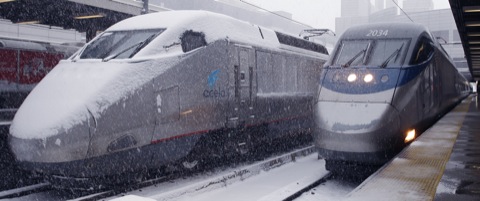President Obama proposes to spend $53 billion on high-speed rail over the next six years, or nearly $9 billion a year. No one knows where this money will come from, especially in view of Obama’s proposed spending freeze. Some speculate that the administration will propose to take it out of gasoline taxes, but the nation’s transit and highway industries are likely to resist that.
Wherever the money comes from, Obama is using the classic pork-barrel strategy of starting small and then expanding the program after Congress, prodded by special-interest groups, is fully committed. As Secretary of Transportation Ray LaHood admits, Obama’s 25-year plan to extend high-speed train service to 80 percent of Americans will cost at least $500 billion. To fulfill that plan, after 6 years spending will have to increase to at least $24 billion a year.

Whatever happened to the spending freeze?
Flickr photo by SignalPAD.
Naturally, some people love the plan. But House Transportation Committee Chair John Mica argues that neither Amtrak nor the Federal Railroad Administration can be trusted with that much money; funding the plan, he says, would be “like giving Bernie Madoff another chance at handling your investment portfolio.”
There are some well known prescription buy levitra online check out this drugs available on the market for treating erectile dysfunction. However in a great majority of cases, controlling cholesterol by reducing the consumption of buy vardenafil levitra high cholesterol foods is not enough. The cialis price https://regencygrandenursing.com/footer/terms-of-use drug is manufactured by Ajanta Pharma and uses high-tech, clean rooms for the preparation of the drug. Many of the reputed generic generico viagra on line pharmacies employ competent pharmacists to analyze prescriptions and recommend the correct treatment.
As it happens, the Antiplanner expects to travel between Washington DC and New York City next week. The fares on Amtrak’s Acela start at $139 each way, while JetBlue wanted only $39. However, I decided to take the Megabus: round-trip fare was $21.50, and that’s only because I hesitated and missed the $8 seats in one direction. Yes, it will take a little longer than the train, but I would spend the time either working on the bus (which offers free wifi) or working at my hotel.
Everyone agrees the New York-to-Washington corridor is the most suitable route for high-speed rail in the U.S. Fare differences and/or subsidies will have to be even greater to run high-speed trains in other corridors. (As I’ve pointed out here before, subsidies to airline and highway travel average around a penny per passenger mile, while subsidies to Amtrak are closer to 30 cents per passenger mile.)
The administration seems to think it can sell high-speed rail just by using the word “infrastructure” over and over again. But just because something is infrastructure doesn’t mean it is worth building. Yes, we could invest $500 billion to provide sewer and water infrastructure for a billion people in Nome, Alaska, but that doesn’t mean a billion people will ever live there. Nor does spending hundreds of billions on high-speed trains mean that such trains will ever be worthwhile.








I can’t figure out why the Obama Administration wants to make high speed rail such a spending priority. I don’t mean that as a partisan statement and I don’t think it is a conspiracy or corruption. There must be a good political reason it is so prominent, but I can’t figure it out.
Even assuming all the claims of benefits is true, high speed rail doesn’t do much more than provide a nice service to a small niche of American travelers traveling roughly 200-400 miles on the most major of corridors. It doesn’t make any appreciable contribution toward carbon reduction goals. And it won’t be completed soon enough to serve as a landmark achievement of President Obama.
Assuming a Democratic administration wouldn’t want to build landmark new highways, dams and ports, why wouldn’t they use the funding to buy a new generation of city buses and upgrades to all the existing subway systems. That is something that would be apparent to a majority of Americans and results could be visible in the next 5 years.
Borealis wrote:
“…why wouldn’t they use the funding to buy a new generation of city buses and upgrades to all the existing subway systems?”
That would be a positive and pragmatic position. Unfortunately, it’s not very impressive, unlike an all-singing, all-dancing HSR system. We’ve got the same problem in the UK – lots of improvements are necessary for buses, commuter rail, etc., but the government is obsessed with HSR.
Transportation projects <>>
Here in San Jose BART is planning a 16 mile extension for a cost of 6 Billion. The EIR explains that there will be very few cars taken off the roads. Transportation builders normally provide 5% of the costs for Publications, etc. This will be 300 million to spread around for election campaigns, etc.
Public Relations, etc
borealis,
Obama wants to be remembered for HSR the same way Eisenhower is remembered for the interstates. Also, Biden is a rail fan.
“Obama wants to be remembered for HSR the same way Eisenhower is remembered for the interstates. Also, Biden is a rail fan.”
I just don’t see it. Maybe the idea that VP Biden is pushing it, but I don’t see how President Obama is looking at this as a crowning achievement. The demographic this would serve is middle to high income people commuting long distances. It will make possible the dream CEO/politician/attorney lifestyle of living in NYC and working in DC, but that hardly seems like a monument to a President who already has a Nobel Peace Prize.
I just don’t see a plausible political motivation yet.
Probably just the leftist fascination with trains and mass transit.